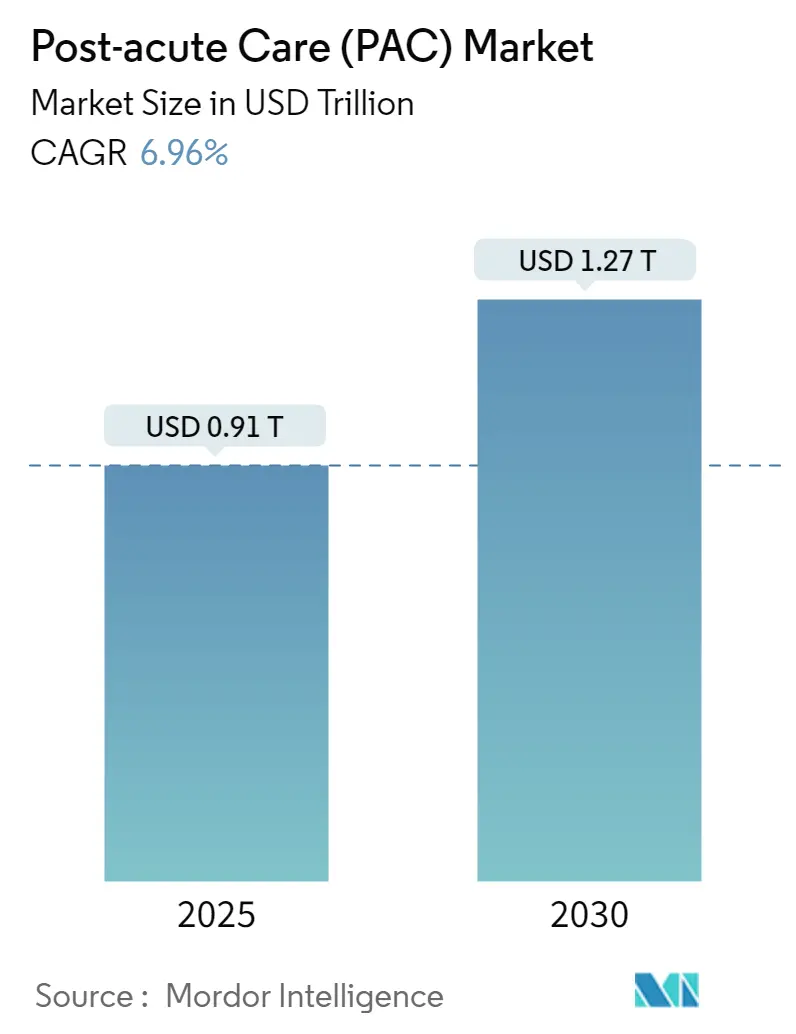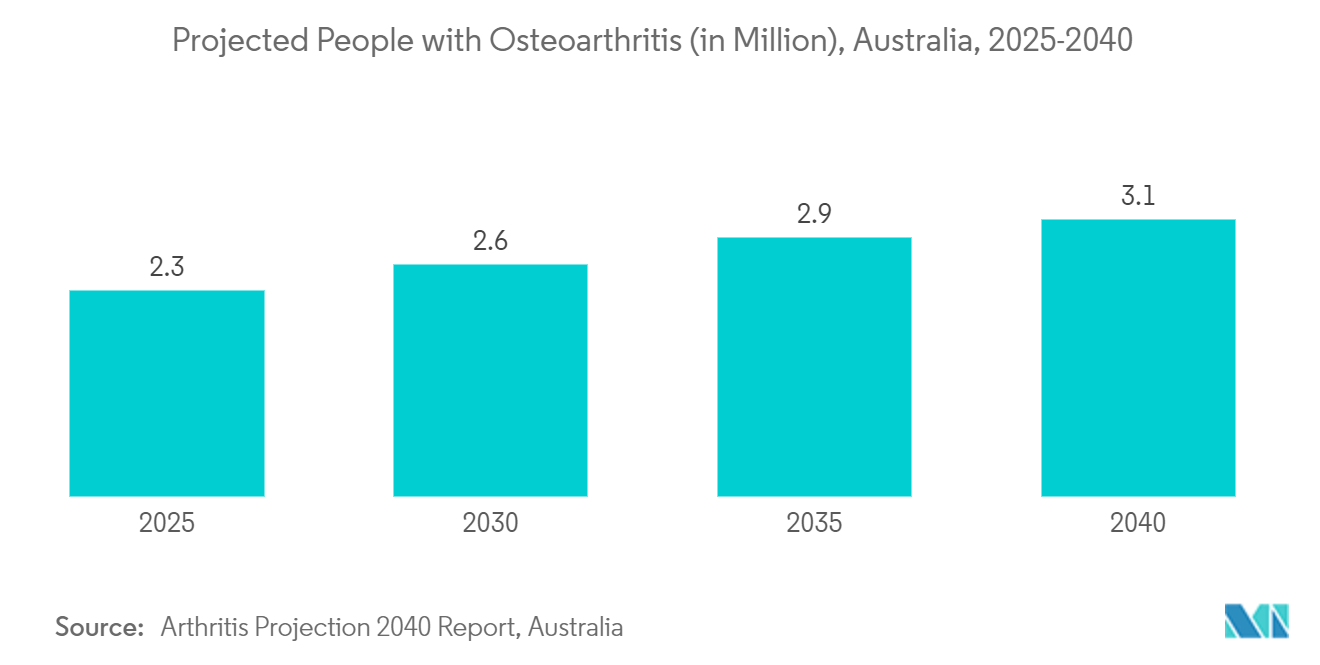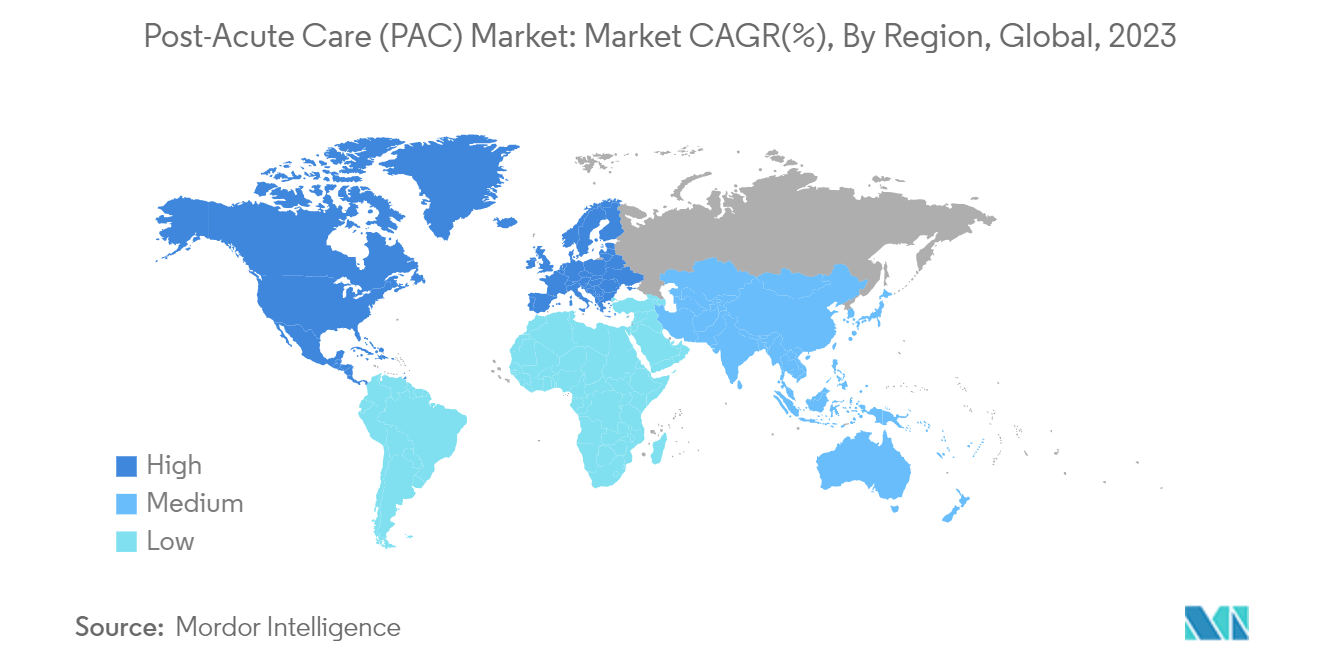
Post-acute Care (PAC) Market Analysis
The Post-acute Care Market size is estimated at USD 0.91 trillion in 2025, and is expected to reach USD 1.27 trillion by 2030, at a CAGR of 6.96% during the forecast period (2025-2030).
Factors such as the rising prevalence of chronic diseases, technological advancements in medical technology, and the growing geriatric population are expected to boost the growth of the post-acute care (PAC) market over the forecast period.
The market is primarily driven by the increasing prevalence of chronic diseases and a growing elderly population. For instance, updated data published by the International Diabetes Federation in 2024 indicates that approximately 643 million individuals are projected to have diabetes by 2030 worldwide, which is expected to reach an estimated 783 million by 2040. Given that diabetes can result in complications like cardiovascular diseases, neuropathy, and kidney problems, there is a consistent demand for post-acute care, monitoring, and rehabilitation services. This ongoing need is expected to boost the market's growth during the forecast period.
Furthermore, as the number of surgical procedures rises, the need for vigilant post-acute care to monitor potential complications, like infections or blood clots, increases. This heightened demand is driving the market's growth. For instance, a January 2023 article published in the Journal of Orthopedic Science reported that about 14,986 knee arthroplasty procedures were projected to be performed in the population aged 75 years and older in Japan by 2030, followed by 6,942 procedures for those aged between 65 and 74 years. In addition, about 4,052 knee arthroplasty procedures were expected to be performed in the population aged 40-64 years in Japan by 2030. These figures indicate a robust upward trajectory for knee arthroplasties in Japan, with most age groups expected to see continued growth over the next decade. Such trends highlight an escalating need for intensive post-surgery rehabilitation, emphasizing the increasing demand for physical and occupational therapy. Consequently, this surge in demand is poised to bolster the market's growth during the forecast period.
Various studies have evaluated the evolution of the post-acute care (PAC) system in China over the past decades. For instance, an article published in the Journal of the American Medical Directors Association in January 2024 noted that China has bolstered its PAC system by enhancing rehabilitation and nursing infrastructure, establishing tiered rehabilitation networks, and adopting innovative payment methods. Also, the increasing elderly population in China, who are more prone to multiple health issues, longer recovery times post-illness, and increased risks of readmission, disability, and mortality, requires the need for long-term care. These factors are expected to heighten the demand for a robust PAC system, suggesting significant growth in the market during the forecast period.
Moreover, various forms and combinations of PAC services have been deployed to stabilize patient's health post-acute hospitalization, promote independent living, curtail unnecessary extended hospital stays, and facilitate smooth transitions between different care levels. These efforts are expected to drive the market's growth during the forecast period. For instance, in April 2024, Netsmart unveiled the Netsmart Marketplace, the largest network of technology and service organizations. This platform offers a wide range of integrated solutions tailored to the evolving demands of value-based care delivery. Through this innovative network, providers in human services, post-acute care, and geriatrics can streamline operations and elevate consumer care by integrating complementary technologies and services. Hence, this is anticipated to have a positive impact on the market's growth.
Therefore, owing to factors such as the rising burden of diabetes and surgical procedures, increasing adoption of post-acute care systems, and launches of post-acute care services, the studied market is expected to grow during the forecast period. However, the lack of skilled personnel, regulatory policies, and reimbursement issues in developing countries are likely to restrict the market's growth during the forecast period.
Post-acute Care (PAC) Market Trends
The Home Health Care Segment is Expected to Witness Significant Growth During the Forecast Period
Home health care enables individuals to access healthcare services at home. They provide various services, such as skilled nursing care, physical, occupational, and speech therapy, medication management, vital sign monitoring, and education on self-care and medical condition management. These services aim to help patients recover, manage their conditions, and uphold their independence. The segment is expected to witness significant growth owing to factors such as the rising demand for home-based care by patients, increasing rates of chronic conditions necessitating ongoing support, cost-effectiveness of home health care services, and technological advancements in home-based care systems.
Various studies have evaluated the effectiveness of home-based rehabilitation for stroke patients during the post-acute care stage. For instance, an article published in the Journal of the Formosan Medical Association in September 2023 highlighted that while home-based rehabilitation was of lower intensity and duration compared to hospital-based rehabilitation, it still led to a significant improvement in the quality of life for stroke patients in post-acute care.
In addition to the above context, home-based rehabilitation benefits the patients and alleviates the caregiving burden on their families. This approach allows patients to engage in real functional activities within their actual home environment. Consequently, the proven effectiveness of home-based post-acute care for stroke patients is expected to drive the demand for home healthcare services, subsequently fueling the segment's growth during the forecast period.
Furthermore, healthcare facilities are increasingly adopting strategic activities, such as partnerships and collaborations, to enhance home-based patient care. This trend is anticipated to drive the segment's growth in the coming years. For instance, in April 2024, SSM Health entered into an innovative partnership with Inbound Health. This collaboration is aimed at delivering tailored, in-home healthcare services to post-hospitalization patients. Through this alliance, patients will benefit from daily in-home and virtual consultations, ensuring top-tier care.
Furthermore, each patient will be equipped with a digital tablet, facilitating enhanced remote monitoring and immediate assistance from the care team. This partnership underscores a significant advancement in the company's commitment to transforming healthcare delivery. Hence, such initiatives are expected to bolster the growth of the home health care segment during the forecast period.
Therefore, owing to the rising number of research studies evaluating the effectiveness of home-based rehabilitation in post-acute care patients, the adoption of strategic activities, and the launch of online platforms for post-acute care providers, the studied segment is expected to grow during the forecast period.

North America is Expected to Hold a Significant Share in the Market During the Forecast Period
North America is expected to witness significant growth in the market during the forecast period owing to factors such as the rising burden of arthritis among the population, rising initiatives to provide post-acute care services, the launch of new hospitals, and the development of technologically advanced post-acute care systems in the region.
Musculoskeletal diseases in the United States, exacerbated by an aging demographic, are causing increasing health and economic challenges. For instance, an April 2024 article from Cureus highlighted that US researchers found a consistent rise in arthritis prevalence, and they observed that arthritis impacted over 58 million adults in the United States in 2022, and this number is projected to reach 78 million by 2040. Arthritis patients often experience pain, mobility issues, and other complications that necessitate specialized post-acute care services, including physical therapy and pain management, hence expected to bolster the market's growth during the forecast period.
Furthermore, the increasing establishment of organizations offering post-acute care services in the region is poised to drive the market's growth during the forecast period. For instance, in February 2024, TeamHealth unveiled TeamACO, an accountable care organization tailored to address the unique healthcare requirements of over 17,000 post-acute care patients across the United States. TeamACO bolsters advanced care planning and aims to minimize readmissions and assess gradual dose reductions to enhance long-term health outcomes for thousands of Medicare enrollees spanning more than 30 states. This is anticipated to bolster the demand for post-acute care services in the region, propelling the market's growth during the forecast period.
Moreover, new post-acute care hospitals are emerging in the region, broadening the spectrum of post-acute care services. This expansion is poised to drive the market's growth in the coming years. For instance, in May 2023, Inova, in collaboration with Select Medical, inaugurated the Inova Select Specialty Hospital at Inova Mount Vernon Hospital. This post-acute care facility caters to patients with specialized needs. These include post-ICU individuals recuperating from chronic and critical illnesses, such as infectious diseases and surgical complications, as well as those with orthopedic, wound, or post-trauma conditions. Additionally, the hospital offers continued treatment for pulmonary and neurological disorders, cardiac issues, and renal conditions. Such initiatives are set to bolster the market's growth during the forecast period.
Therefore, owing to the rising burden of arthritis among the population, the launch of various organizations and hospitals to provide post-acute care services, and the development of technologically advanced PAC systems by the companies, the studied market is expected to grow during the forecast period.
Post-acute Care (PAC) Industry Overview
The post-acute care market is semi-consolidated as many skilled nursing and rehabilitation centers tend to be regionally concentrated, with a few large providers dominating specific areas. The ongoing collaborations and partnership activities among healthcare organizations have led to a concentration of services among fewer companies. Some of the key players in the market are Brookdale Senior Living Inc., Amedisys Inc., LHC Group, Genesis Healthcare, and Kindred Healthcare.
Post-acute Care (PAC) Market Leaders
-
Kindred Healthcare
-
LHC Group
-
Genesis Healthcare
-
Brookdale Senior Living Inc.
-
Amedisys Inc .
- *Disclaimer: Major Players sorted in no particular order
Post-acute Care (PAC) Market News
- May 2024: Torres and Cape Hospital and Health Service (TCHHS) introduced a new palliative care service under its Post-Acute Care and Rehabilitation and Aged Care (PARAC) team. The service is staffed by a clinical nurse and an Aboriginal and Torres Strait Islander Health Worker, both of whom have received specialized training to cater to community needs.
- April 2024: CareDirections, in collaboration with Carium, introduced StrokeCP, a post-acute stroke care solution developed by Atrium Health Wake Forest Baptist. This platform integrates a suite of tools and interventions, all validated to enhance care management for stroke survivors after discharge. As a result, health systems witness not only improved quality outcomes but also a reduction in care costs. With StrokeCP, patients leave with a tailored care plan for a successful long-term recovery and optimal quality outcomes.
Post-acute Care (PAC) Industry Segmentation
As per the scope of the report, post-acute care refers to a range of healthcare services and support provided to individuals recovering from an acute illness, injury, or surgery. It focuses on helping patients regain their functional abilities, improve their quality of life, and transition back to their home or community setting. Post-acute care is a critical component of the healthcare continuum, providing specialized medical and rehabilitative services to individuals who require continued care after being discharged from a hospital.
The post-acute care market is segmented into services, patient type, application, and geography. By services, the market is segmented into skilled nursing facilities, inpatient rehabilitation facilities, long-term acute care hospitals, home health care, and other services. By patient type, the market is segmented into elderly, adult, and other patient types. By application, the market is segmented into amputations, wound management, brain injury and spinal cord injury, neurological disorders, and other applications. By geography, the market is divided into North America, Europe, Asia-Pacific, Middle East and Africa, and South America. For each segment, the market sizes and forecasts were made based on value (USD).
| By Service | Skilled Nursing Facilities | ||
| Inpatient Rehabilitation Facilities | |||
| Long-term Acute Care Hospitals | |||
| Home Health Care | |||
| Other Services (Assisted Living Facilities, Outpatient Clinics, and Palliative Care Facilities) | |||
| By Patient Type | Elderly | ||
| Adult | |||
| Other Patient Types (Children and Neonates) | |||
| By Application | Amputations | ||
| Wound Management | |||
| Brain Injury and Spinal Cord Injury | |||
| Neurological Disorders | |||
| Other Applications (Cardiovascular Diseases, Renal Diseases, Orthopedic Disorders, and Infections) | |||
| Geography | North America | United States | |
| Canada | |||
| Mexico | |||
| Europe | Germany | ||
| United Kingdom | |||
| France | |||
| Italy | |||
| Spain | |||
| Rest of Europe | |||
| Asia-Pacific | China | ||
| Japan | |||
| India | |||
| Australia | |||
| South Korea | |||
| Rest of Asia-Pacific | |||
| Middle East and Africa | GCC | ||
| South Africa | |||
| Rest of Middle East and Africa | |||
| South America | Brazil | ||
| Argentina | |||
| Rest of South America | |||
Post-acute Care (PAC) Market Research FAQs
How big is the Post-acute Care Market?
The Post-acute Care Market size is expected to reach USD 0.91 trillion in 2025 and grow at a CAGR of 6.96% to reach USD 1.27 trillion by 2030.
What is the current Post-acute Care Market size?
In 2025, the Post-acute Care Market size is expected to reach USD 0.91 trillion.
Who are the key players in Post-acute Care Market?
Kindred Healthcare, LHC Group, Genesis Healthcare, Brookdale Senior Living Inc. and Amedisys Inc . are the major companies operating in the Post-acute Care Market.
Which is the fastest growing region in Post-acute Care Market?
Asia Pacific is estimated to grow at the highest CAGR over the forecast period (2025-2030).
Which region has the biggest share in Post-acute Care Market?
In 2025, the North America accounts for the largest market share in Post-acute Care Market.
What years does this Post-acute Care Market cover, and what was the market size in 2024?
In 2024, the Post-acute Care Market size was estimated at USD 0.85 trillion. The report covers the Post-acute Care Market historical market size for years: 2019, 2020, 2021, 2022, 2023 and 2024. The report also forecasts the Post-acute Care Market size for years: 2025, 2026, 2027, 2028, 2029 and 2030.
Post-acute Care (PAC) Industry Report
Statistics for the 2025 Post-acute Care (PAC) market share, size and revenue growth rate, created by Mordor Intelligence™ Industry Reports. Post-acute Care (PAC) analysis includes a market forecast outlook for 2025 to 2030 and historical overview. Get a sample of this industry analysis as a free report PDF download.

-market---MP.webp)

-market---CL.webp)

